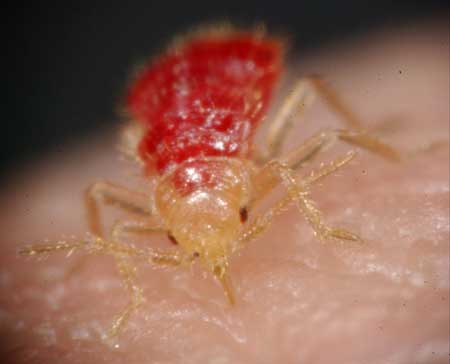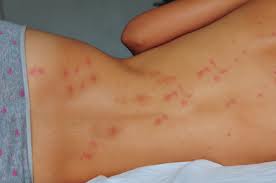June 14th, 2013 by
 Here at HSDonline, we've had a lot of people desperate to know how to get rid of bed bugs. Here is quick and easy guide to understand where they're coming from and how to get rid of them!
Here at HSDonline, we've had a lot of people desperate to know how to get rid of bed bugs. Here is quick and easy guide to understand where they're coming from and how to get rid of them!
What are bed bugs?
Bed bugs are flattened oval body parasitic insects that feed exclusively on blood. A bit bigger than a grain of rice (0.15 to 0.27 inches) which makes it difficult to spot them. They can easily be mistaken for tiny dirt particles. Their colour varies from the yellow to dark red-brown, according to the stage of development and the ingested blood. The bed bugs eggs are white and measure approximately 0.039 inches long. The common bed bugs are scientifically called "cimex lectularius".  Microscopic picture of a bed bug Their favourite food is human blood and they preferably feed at night time, which is why we are bitten at night when we are asleep. The bed bug generally hides in the folds of mattresses and bed bases. Bed bugs like dark and quiet places, such as cracks in walls, in plug sockets and behind picture frames.
Microscopic picture of a bed bug Their favourite food is human blood and they preferably feed at night time, which is why we are bitten at night when we are asleep. The bed bug generally hides in the folds of mattresses and bed bases. Bed bugs like dark and quiet places, such as cracks in walls, in plug sockets and behind picture frames.
Why are bed bugs infestations increasing?
In the late 90s, bed bug infestations became more common but the reasons for these infestations are not clearly known. Different factors mentioned by specialists could be an increase of international journeys and also the ability of bed bugs to be more resistant to weak insecticides. You've got bed bugs if you notice any of the followings:
- The presence of visible bites on the skin, often in rows or/and grouped.
- The presence of bedbugs and their excrement: small black spots on the mattress, sheets, the bed base or walls.
- The presence of big and long tracks of blood on sheets. They may be squashed by a person when asleep.
What do bed bug bites look like?
The bite of a bed bug is usually painless for 1 to 2 hours (they inject you with a small anaesthetic) but afterwards may become itchy and red marks may appear on the skin (similar to a mosquito bite). They are mainly known for dermatological and allergic infringement which can be caused from simple bite. In some cases, a localised allergic reaction (similar to a nettle rash) can appear as red blotches on the skin. In rare cases, it can also evolve into a general allergic reaction. If you suffer from persistent itches, you must consult your doctor who will prescribe you a cream relief. You can also read the NHS recommendations in order to treat it yourself.  Bed bug bites The sensitivity of a person can increase when bitten many times. In case of severe infestation, bed bugs can also be sources of other physiological conditions, such as anaemia. The bites are generally located on uncovered parts of the body such as arms, legs and the back. Most of the time, bed bugs bite disappears after 5-10 days and do not require particular care. Make sure to clean your skin and try not to scratch it to avoid any secondary infection. Bed bugs are not a disease vector and don't spread disease.
Bed bug bites The sensitivity of a person can increase when bitten many times. In case of severe infestation, bed bugs can also be sources of other physiological conditions, such as anaemia. The bites are generally located on uncovered parts of the body such as arms, legs and the back. Most of the time, bed bugs bite disappears after 5-10 days and do not require particular care. Make sure to clean your skin and try not to scratch it to avoid any secondary infection. Bed bugs are not a disease vector and don't spread disease.
How to get rid of bed bugs?
Now that you've checked your health, it's time to get rid of bed bugs. You will need specialist products using chemical elements to get rid of bed bugs, such as Protector C Bed Bug Spray, Fortefog Fumers and Residex P Powder. These are all essential to get rid of bed bugs and are all government approved chemical treatments to work. (A step by step guide comes with any of these products to help you eradicate and get rid of bed bugs). More precious and detailed advice about our different chemical treatments can be found here.
How to avoid another infestation of bed bugs?
When travelling, it's important to carefully inspect the bed of your hotel room in order to detect and later on, get rid of bed bugs. Make sure that no bed bugs are in the room before settling your clothes in cupboards or lay on the bed. Everybody can be a victim at home of an infestation and their presence do not indicate a lack of cleanliness.
The quicker you spot these signs, and the quicker you treat affected rooms determines how quickly a bed bug infestation is avoided.
After using chemical treatments to get rid of bed bugs, here a few tips to avoid another infestation:
- Contain the infestation: If you think your furniture (e.g. bed, sofa) is infested, don't move it to another part of the house or into the garden, as you'll spread the infestation.
- Use a vacuum cleaner provided with a sucking beak to capture eggs and insects. Attention, the vacuum cleaner does not kill them!! They can then escape a few minutes or hours later. The vacuum cleaner must be cleaned and the vacuum bag packed in a plastic bag thrown in an outside sealed bin in order to avoid any contamination.
- Wash (washing machine) all your clothes, pillows and linen if you suspect that they are contaminated. A hot wash of at least 55°C is needed to kill the insects.
- Fill cracks being between skirting boards , wooden bed frames and walls.
Other resources:
Tipsbulletin guide on getting rid of bedbugs at home - click HERE
Enjoyed? Check out our latest posts
Comments
Leave a reply
Your e-mail address will not be published. All fields are required


